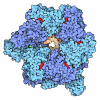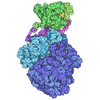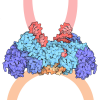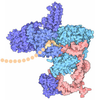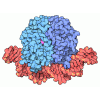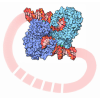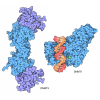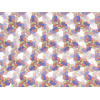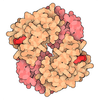[English] 日本語
 Yorodumi
Yorodumi- PDB-9nn2: Composite structure of HSV-1 helicase-primase in complex with a f... -
+ Open data
Open data
- Basic information
Basic information
| Entry | Database: PDB / ID: 9nn2 | |||||||||
|---|---|---|---|---|---|---|---|---|---|---|
| Title | Composite structure of HSV-1 helicase-primase in complex with a forked DNA and amenamevir | |||||||||
 Components Components |
| |||||||||
 Keywords Keywords | Transferase/Hydrolase / DNA replication / HSV-1 helicase-primase / VIRAL PROTEIN / Transferase-Hydrolase complex | |||||||||
| Function / homology |  Function and homology information Function and homology informationbidirectional double-stranded viral DNA replication / helicase activity / Hydrolases; Acting on acid anhydrides; Acting on acid anhydrides to facilitate cellular and subcellular movement / Transferases; Transferring phosphorus-containing groups; Nucleotidyltransferases / DNA-directed RNA polymerase activity / DNA replication / hydrolase activity / host cell nucleus / zinc ion binding / ATP binding Similarity search - Function | |||||||||
| Biological species |  Human alphaherpesvirus 1 strain 17 Human alphaherpesvirus 1 strain 17 Homo sapiens (human) Homo sapiens (human) | |||||||||
| Method | ELECTRON MICROSCOPY / single particle reconstruction / cryo EM / Resolution: 3.1 Å | |||||||||
 Authors Authors | He, Q. / Baranovskiy, A.G. / Morstadt, L.M. / Babayeva, N.D. / Lim, C. / Tahirov, T.H. | |||||||||
| Funding support |  United States, 2items United States, 2items
| |||||||||
 Citation Citation |  Journal: Sci Adv / Year: 2025 Journal: Sci Adv / Year: 2025Title: Structural basis of herpesvirus helicase-primase inhibition by pritelivir and amenamevir. Authors: Andrey G Baranovskiy / Qixiang He / Yoshiaki Suwa / Lucia M Morstadt / Nigar D Babayeva / Ci Ji Lim / Tahir H Tahirov /  Abstract: Widespread herpesvirus infections are associated with various diseases. DNA replication of human herpes simplex virus type 1 (HSV-1) requires a helicase-primase (HP) complex of three core proteins: ...Widespread herpesvirus infections are associated with various diseases. DNA replication of human herpes simplex virus type 1 (HSV-1) requires a helicase-primase (HP) complex of three core proteins: UL5, UL52, and UL8. This complex unwinds viral DNA and synthesizes primers for DNA replication, making it an attractive antiviral target. Although HP inhibitors pritelivir and amenamevir were identified through screening, their binding mechanisms remain unclear. Here, we report cryo-electron microscopy structures of HSV-1 HP bound to a forked DNA template alone and in complex with pritelivir or amenamevir. The structures reveal a bilobed architecture highlighting HP coordinated action at the replication fork and providing a structural basis for HP inhibition by illustrating precisely how pritelivir and amenamevir block helicase activity. Data lay a solid foundation for the development of improved antiviral therapies. | |||||||||
| History |
|
- Structure visualization
Structure visualization
| Structure viewer | Molecule:  Molmil Molmil Jmol/JSmol Jmol/JSmol |
|---|
- Downloads & links
Downloads & links
- Download
Download
| PDBx/mmCIF format |  9nn2.cif.gz 9nn2.cif.gz | 509.6 KB | Display |  PDBx/mmCIF format PDBx/mmCIF format |
|---|---|---|---|---|
| PDB format |  pdb9nn2.ent.gz pdb9nn2.ent.gz | Display |  PDB format PDB format | |
| PDBx/mmJSON format |  9nn2.json.gz 9nn2.json.gz | Tree view |  PDBx/mmJSON format PDBx/mmJSON format | |
| Others |  Other downloads Other downloads |
-Validation report
| Summary document |  9nn2_validation.pdf.gz 9nn2_validation.pdf.gz | 985.5 KB | Display |  wwPDB validaton report wwPDB validaton report |
|---|---|---|---|---|
| Full document |  9nn2_full_validation.pdf.gz 9nn2_full_validation.pdf.gz | 1 MB | Display | |
| Data in XML |  9nn2_validation.xml.gz 9nn2_validation.xml.gz | 70.6 KB | Display | |
| Data in CIF |  9nn2_validation.cif.gz 9nn2_validation.cif.gz | 110.3 KB | Display | |
| Arichive directory |  https://data.pdbj.org/pub/pdb/validation_reports/nn/9nn2 https://data.pdbj.org/pub/pdb/validation_reports/nn/9nn2 ftp://data.pdbj.org/pub/pdb/validation_reports/nn/9nn2 ftp://data.pdbj.org/pub/pdb/validation_reports/nn/9nn2 | HTTPS FTP |
-Related structure data
| Related structure data |  49563MC  9nnpC  9nqpC C: citing same article ( M: map data used to model this data |
|---|---|
| Similar structure data | Similarity search - Function & homology  F&H Search F&H Search |
- Links
Links
- Assembly
Assembly
| Deposited unit | 
|
|---|---|
| 1 |
|
- Components
Components
-DNA chain , 1 types, 1 molecules D
| #1: DNA chain | Mass: 13114.381 Da / Num. of mol.: 1 / Source method: obtained synthetically / Source: (synth.)  Homo sapiens (human) Homo sapiens (human) |
|---|
-Protein , 3 types, 3 molecules ABC
| #2: Protein | Mass: 95760.805 Da / Num. of mol.: 1 Source method: isolated from a genetically manipulated source Source: (gene. exp.)  Human alphaherpesvirus 1 strain 17 / Gene: HELI, UL5 / Production host: Human alphaherpesvirus 1 strain 17 / Gene: HELI, UL5 / Production host:  References: UniProt: P10189, Hydrolases; Acting on acid anhydrides; Acting on acid anhydrides to facilitate cellular and subcellular movement |
|---|---|
| #3: Protein | Mass: 114558.562 Da / Num. of mol.: 1 Source method: isolated from a genetically manipulated source Source: (gene. exp.)  Human alphaherpesvirus 1 strain 17 / Gene: UL52 / Production host: Human alphaherpesvirus 1 strain 17 / Gene: UL52 / Production host:  References: UniProt: P10236, Transferases; Transferring phosphorus-containing groups; Nucleotidyltransferases |
| #4: Protein | Mass: 80005.664 Da / Num. of mol.: 1 Source method: isolated from a genetically manipulated source Source: (gene. exp.)  Human alphaherpesvirus 1 strain 17 / Gene: UL8 / Production host: Human alphaherpesvirus 1 strain 17 / Gene: UL8 / Production host:  |
-Non-polymers , 3 types, 7 molecules 
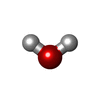

| #5: Chemical | ChemComp-A1BXD / Mass: 482.552 Da / Num. of mol.: 1 / Source method: obtained synthetically / Formula: C24H26N4O5S / Feature type: SUBJECT OF INVESTIGATION | ||
|---|---|---|---|
| #6: Chemical | | #7: Water | ChemComp-HOH / | |
-Details
| Has ligand of interest | Y |
|---|---|
| Has protein modification | N |
-Experimental details
-Experiment
| Experiment | Method: ELECTRON MICROSCOPY |
|---|---|
| EM experiment | Aggregation state: PARTICLE / 3D reconstruction method: single particle reconstruction |
- Sample preparation
Sample preparation
| Component | Name: HSV-1 helicase-primase in complex with a forked DNA and amenamevir Type: COMPLEX Details: HSV-1 helicase-primase in complex with a forked DNA and amenamevir sovled using cryo-EM single-particle analysis Entity ID: #1-#4 / Source: RECOMBINANT | ||||||||||||||||||||||||||||||
|---|---|---|---|---|---|---|---|---|---|---|---|---|---|---|---|---|---|---|---|---|---|---|---|---|---|---|---|---|---|---|---|
| Molecular weight | Value: 0.3 MDa / Experimental value: NO | ||||||||||||||||||||||||||||||
| Source (natural) | Organism:  Human alphaherpesvirus 1 strain 17 Human alphaherpesvirus 1 strain 17 | ||||||||||||||||||||||||||||||
| Source (recombinant) | Organism:  | ||||||||||||||||||||||||||||||
| Buffer solution | pH: 7.5 Details: CHAPSO is made fresh at 80 mM before being added to the sample at a final concentration of 2 mM immediately before vitrification | ||||||||||||||||||||||||||||||
| Buffer component |
| ||||||||||||||||||||||||||||||
| Specimen | Conc.: 5.4 mg/ml / Embedding applied: NO / Shadowing applied: NO / Staining applied: NO / Vitrification applied: YES / Details: The sample was monodisperse | ||||||||||||||||||||||||||||||
| Vitrification | Instrument: FEI VITROBOT MARK IV / Cryogen name: ETHANE / Humidity: 95 % / Chamber temperature: 277.15 K |
- Electron microscopy imaging
Electron microscopy imaging
| Experimental equipment |  Model: Titan Krios / Image courtesy: FEI Company |
|---|---|
| Microscopy | Model: TFS KRIOS |
| Electron gun | Electron source:  FIELD EMISSION GUN / Accelerating voltage: 300 kV / Illumination mode: SPOT SCAN FIELD EMISSION GUN / Accelerating voltage: 300 kV / Illumination mode: SPOT SCAN |
| Electron lens | Mode: BRIGHT FIELD / Nominal defocus max: 2500 nm / Nominal defocus min: 1000 nm |
| Image recording | Electron dose: 50 e/Å2 / Film or detector model: GATAN K3 (6k x 4k) / Num. of grids imaged: 1 / Num. of real images: 12660 |
- Processing
Processing
| EM software |
| ||||||||||||||||||||||||
|---|---|---|---|---|---|---|---|---|---|---|---|---|---|---|---|---|---|---|---|---|---|---|---|---|---|
| CTF correction | Type: PHASE FLIPPING AND AMPLITUDE CORRECTION | ||||||||||||||||||||||||
| Particle selection | Num. of particles selected: 4689246 | ||||||||||||||||||||||||
| Symmetry | Point symmetry: C1 (asymmetric) | ||||||||||||||||||||||||
| 3D reconstruction | Resolution: 3.1 Å / Resolution method: FSC 0.143 CUT-OFF / Num. of particles: 725691 / Num. of class averages: 1 / Symmetry type: POINT | ||||||||||||||||||||||||
| Atomic model building | Protocol: RIGID BODY FIT | ||||||||||||||||||||||||
| Atomic model building | Source name: AlphaFold / Type: in silico model | ||||||||||||||||||||||||
| Refinement | Highest resolution: 3.1 Å Stereochemistry target values: REAL-SPACE (WEIGHTED MAP SUM AT ATOM CENTERS) | ||||||||||||||||||||||||
| Refine LS restraints |
|
 Movie
Movie Controller
Controller













 PDBj
PDBj
